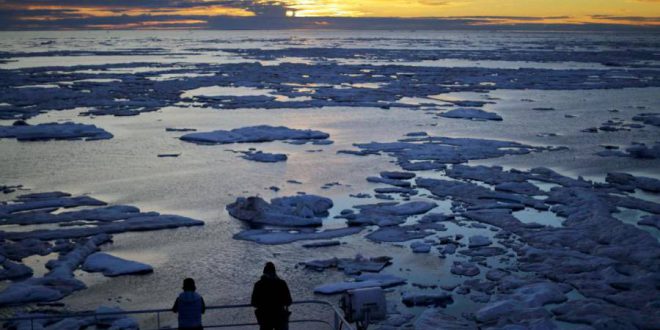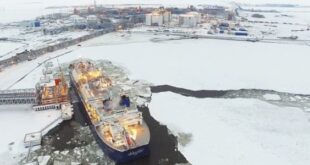Diplomats gathered in Rovaniemi to discuss the state of the North Pole were caught off-guard by the United States’ posturing. In a speech to the Arctic Council. U.S. Secretary of State Mike Pompeo sharply warned against China’s increasing economic activity on the North Pole and the potential militarization of its projects. The Arctic Council is the main intergovernmental forum on Arctic affairs and its mandate does not cover security issues. Therefore. his remarks were unusual and raised important questions. To what degree could China’s polar aspirations pose a threat to the regional stability of the Arctic Circle?
Chinese investments in the Arctic
Some of China’s investments have been welcomed by regional actors. and include the China Iceland Joint Arctic Science Observatory. Its costs were covered fully by the Chinese government. according to Halldor Johannsson. vice-chair of the new research facility located in Northern Iceland. Originally meant to monitor the northern lights. both parties have already committed to expanding its activities. Despite earlier suspicions in 2011 regarding investments by a Chinese billionaire. Iceland’s attitude towards scientific cooperation with China remains neutral. and the Observatory was inaugurated in October 2018.
In Greenland. melting glaciers provide new opportunities for the exploration of natural resources. Chinese companies are involved in six different projects. including a partnership with the Australian company to extract uranium and rare earth minerals. which may serve a growing demand for the latter in China. While environmental concerns have been raised. international cooperation on natural resource extraction could reduce Greenland’s current reliance on Danish subsidies.
However. in other cases. Chinese investments have been met with wary eyes. A sparsely populated but vast island. Greenland relies on aviation for the transport of both goods and people. When in 2017 two Chinese construction companies applied for a government tender to build three airports. their bid to improve the infrastructure network of the island sparked fears of a Chinese takeover in the Danish Parliament. In order to prevent Greenland from falling into a potential `debt trap`. Denmark offered to finance the projects instead.
In Sweden. a newly opened research facility in Kiruna has also been put under scrutiny after the Swedish Defense Research Agency. an entity of Sweden’s Ministry of Defense. argued that its monitoring capabilities could be abused by the Chinese military. China’s first wholly-owned satellite ground station opened in January 2019 and is meant to improve global satellite data reception. Yet the highly blurred lines between the civilian and military sphere in China’s space efforts mean that potential military applications of its new satellite base cannot be ruled out. It is these concerns that fuel U.S. antagonism towards a growing Chinese presence on the North Pole.
Simply business?
These investments are exemplary of China’s wish to become a `polar great power`. a term first used by President Xi Jinping in 2014. Its aspirations in the polar regions have become clearer since January 2018. when the State Council Information Office released a white paper entitled ‘China’s Arctic Policy’. This document outlines some of China’s economic and scientific interests in the Arctic but refrains from mentioning any long term military and strategic goals.
More specifically. the paper calls for international cooperation in order to develop a new shipping route through the Arctic. The new route. called the Northern Sea Route. shaves off 15 days of the shipping time and allows ships to navigate Russian waters in order to enter the seas of Western Europe. Since 2013. Chinese shipping company COSCO has conducted 22 commercial voyages and its cargo volume is predicted to increase in the coming years.
Furthermore. the emphasis is placed on the potential extraction of both natural and living resources. In addition to its activities in Greenland. China is also involved in a Sino-Russian joint venture in Yamal. Russia. to extract liquified natural gas. A recent bureaucratic shuffle in March 2018 has put the Chinese Arctic and Antarctic Administration under the direct supervision of the new Ministry of Natural Resources. This illustrates the importance the Chinese government attaches to the potential economic utilization of the Arctic.
While business interests thus dominate Chinese foreign policy in the far north. other intentions likely play a role as well. The Arctic. for example. is perceived by Chinese researchers as a barometer for climate change. the latter which may have a direct impact on Chinese national security. Rising sea levels. for example. threaten to flood Chinese coastal regions. including its highly industrialized Pearl River Delta. And although the government has withheld from commenting on military affairs in an official capacity. academics from institutions of the People’s Liberation Army continue to engage in discussions on the geostrategic implications of melting ice caps.
The snowy road ahead
Governance in the Arctic is an extremely convoluted process. however: rather than one single regime. the region is governed by a patchwork of international treaties. hile the Arctic Council exercises some influence. the current regulatory framework favours the five littoral states of Canada. Denmark. the United States. Russia. and Norway. In the 2008 Ilulissat Declaration. this group asserted its primacy in Arctic affairs. effectively preventing the creation of a comprehensive Arctic Treaty without its approval.
Although Chinese scholars have raised their concerns about the exclusionary nature of the current regime structure. officials are careful not to make any public statements. Despite the restrictions that the current Arctic regime poses for China. the current treaties in place provide some leeway for the country to engage in its interests. China is therefore likely to continue to push for international cooperation in these fields. It will be eager to avoid securitization of the region. Scientific investments. such as those in Iceland. form an opportunity to forge bonds with potential Arctic allies. including its own neighbours: since 2013. China. Japan. and Korea have held yearly summits on Arctic cooperation.
As climate change takes centre stage in the Arctic Council. China remains off the radar – for now. Its activities in the far north are limited as of now. Chinese militarization is unlikely in the foreseeable future as the country continues to build ties with what it regards as key stakeholders in the region. Military use of civilian technology. however. cannot be ruled out and these uncertainties may fuel further hostility of the United States towards China’s policies abroad. Much like its unease towards the use of Chinese 5G technology. it is probable that an increasing amount of Chinese ventures around the Arctic Ocean may become yet another factor contributing to the growing distrust between the two nations.
 Iran Energy News Oil, Gas, Petrochemical and Energy Field Specialized Channel
Iran Energy News Oil, Gas, Petrochemical and Energy Field Specialized Channel




